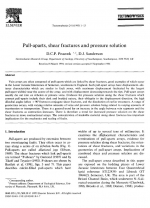Добрый день, Коллеги. Важное сообщение, просьба принять участие. Музей Ферсмана ищет помощь для реставрационных работ в помещении. Подробности по ссылке
Pull-aparts, shear fractures and pressure solution
Vein arrays are often composed of pull-aparts which are linked by shear fractures, good examples of which occur in the Lower Jurassic limestones of Somerset, southwestern England. Such pull-apart arrays have displacement-distance characteristics which are similar to fault zones, with maximum displacement (indicated by the largest pull-apart widths) near the centre of the array, and with displacement decreasing towards the tips. Pull-apart arrays usually die out into en echelon or pinnate veins. Evidence for pressure solution along the shear fractures which connect pull-aparts include their dark and braided nature, their obliquity to the displacement direction, the high dihedral angles (often > 90°) between conjugate shear fractures, and the dissolution of earlier structures. A range of geometries occurs, with varying relative amounts of veins and pressure solution being related to varying amounts of transtension or transpression. There is a general trend for an increase in the angle between vein segments and the shear fractures as contraction increases. There is therefore a trend for increased pressure solution on the shear fractures in more contractional arrays. The concentration of insoluble material along shear fractures has important implications for the mechanics and sealing of faults.




